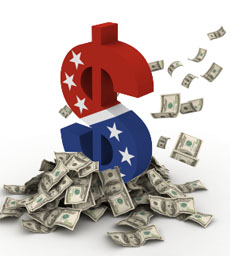SIDEBAR: US finance rescue plan aims to help healthy companies
 Washington - The US treasury secretary and central bank head Thursday outlined details of a historic finance rescue plan that would help healthy finance firms and banks in addition to propping up weak or troubled companies.
Washington - The US treasury secretary and central bank head Thursday outlined details of a historic finance rescue plan that would help healthy finance firms and banks in addition to propping up weak or troubled companies.
Speaking before the US Senate banking committee, Secretary Henry Paulson and Federal Reserve chair Ben Bernanke described a broad- based plan that would purchase bad mortgage debts and complex mortgage-related-securities-gone-sour from mostly successful banks and investment houses.
The idea would be to keep them one step ahead of the bankruptcy monster eating its way through the pillars of the US finance system.
The 700-billion-dollar plan would be the largest government intervention in capital markets since the Great Depression of the 1930s, and has provoked public anger that tax dollars would be used to clean up years of unregulated Wall Street greed.
US President George W Bush's financial lieutenants have been working on the plan for months in anticipation of the crisis, White House spokesman Tony Fratto said Tuesday.
But the government only presented it to Congress over the weekend after days of extreme market turmoil, bankruptcies and bailouts, with a demand that legislators adopt the mammoth programme in a week.
The two officials are to testify before the House of Representatives' finance panel on Wednesday. Vice President Dick Cheney and other officials were also on Capitol Hill lobbying for congressional support on Tuesday.
The White House said the need for speedy action was urgent and "dire" after credit markets froze last week.
"This had very, very real impacts on numerous businesses around the country even in just their ability to get overnight financing for their ongoing operations, to pay employees and to purchase equipment and the things that go into the products they make," Fratto said.
Bernanke and Paulson conceded that they were entering unchartered territory, and would have to experiment with how best to acquire and manage the "toxic assets," as many senators called them Tuesday.
Bernanke offered some insight into the complex process, describing a sort of "reverse auction" where companies would have to offer the bad assets to the government at a low price.
But Bernanke also said the government may have to buy the assets at above-market values to be of help to financial firms in freeing up credit.
"Accounting rules require banks to value many assets at something close to a very low fire-sale price rather than the hold-to-maturity price," Bernanke told the panel. "If the Treasury bids for and then buys assets at a price close to the hold-to-maturity price, there will be substantial benefits."
The Fed chief said paying prices higher than the bad assets would fetch in the open market would help "unfreeze" credit markets and aid the economy.
The problem, Bernanke admitted, is that no one knows "exactly what the best design is."
Paulson and Bernanke tried to assure sceptical senators that taxpayers could profit once home and mortgage values appreciate to "maturity" as credit is freed up. Short of that, the government could at least recoup the initial investment, although there was no guarantee.
Wary legislators have demanded, and apparently gotten, a concession from the White House that a strict oversight authority be put in place to monitor the unprecedented expenditure of public moneys and authority for the US treasury.
But Bernanke and Paulson opposed demands that limits be put on executive compensation for participating companies and that the US government secure options to buy shares in the companies as collateral for the tax investment.
They warned such moves would be seen as "punitive" and could scare companies off of joining the plan. (dpa)